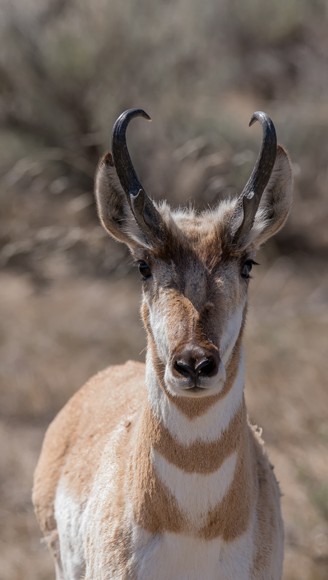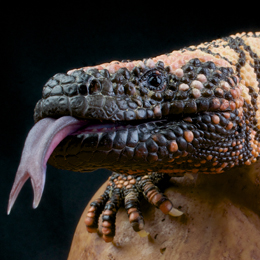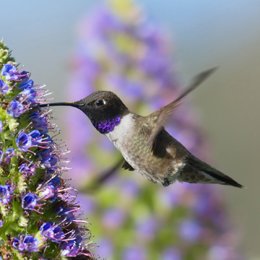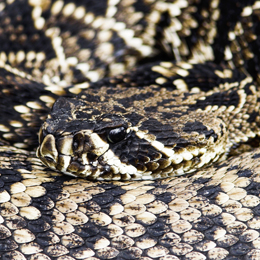Description
The scientific name for pronghorns is Antilocapra americana. Antilo means antelope and capra means a male goat. They are the only surviving members of the Antilocapridae family in North America.
Pronghorns are the big game animals of North America with branched horns. They are also called pronghorn antelopes, prong buck, or just antelopes. It should be noted that they are not antelopes but bear a striking resemblance to the Old World antelopes. Because of the unique branched horns, they are called pronghorns.
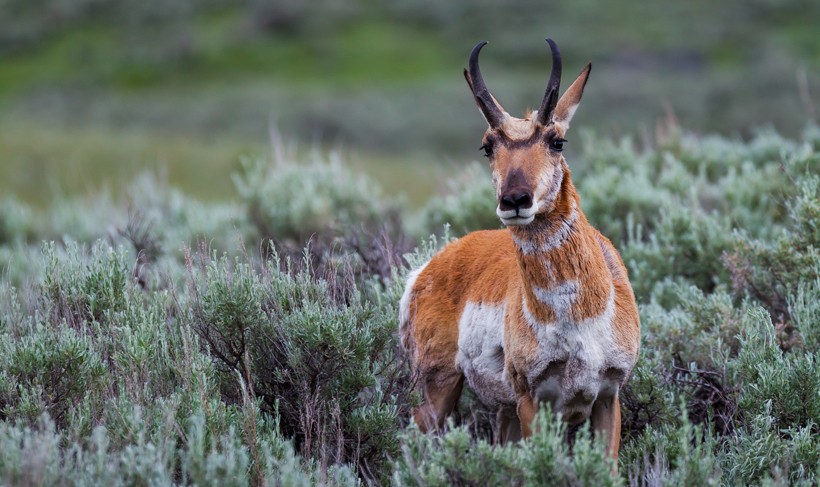
The black branched horns are a distinguishing trait that is unique to the Antilocapridae family.
?
Image credits: puttsk/Shutterstock
These deer-like mammals are small with an average size of 1.3–1.5 m (4 ft 3 in–4 ft 11 in) in length and 81–104 cm (32–41 in) high. Both male (buck) and female (does) pronghorns grow up to the same height and length. The difference between the bucks and does lies in their weight. Adult male pronghorns weigh about 40–65 kg (88–143 lbs) whereas the weight of adult females are around 34–48 kg (75–106 lbs).
The black branched horns are a distinguishing eye-catcher that is unique to the Antilocapridae family. Both the sexes have forked horns. However, female horns are underdeveloped or the growth is stunted. The horns of males grow up to 30–50 cm (11.8–19.7 in) while this is 7.5-10 cm (2.9-3.9 in) for female horns. Moreover, males have lyre-shaped horns that curve inwards whereas females usually have straight horns. Male pronghorns show black marks on the face, starting below the eyes all the way up to their nose. Females lack these black markings.
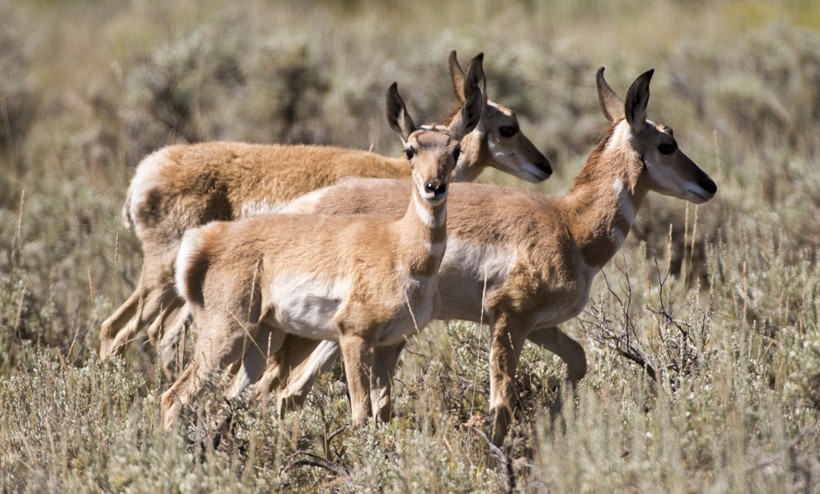
As diurnal animals, pronghorns are active between at dawn and dusk.
?
Image credits: Greg and Jan Ritchie/Shutterstock
Pronghorns have a lifespan of approximately 10 years on average. Thanks to the large and protruding eyes, they have an excellent vision. In fact, pronghorns have the largest set of eyes in relation to their bodies among all the North American hoofed animals, giving them an about 300-degree arc of vision.
Any sort of movement can be easily detected without moving their eyes or head. The American antelopes perceive moving objects easier than the stationary ones.
Subspecies
There are 5 subspecies of pronghorns: A. a. americana, A. a. mexicana, A. a. peninsularis, A. a. oregona, and A. a. sonoriensis. They are categorized on the basis of their geographical locations and minor color- and size differences.
- A. a. americana
These subspecies habitats the United States and Canada. - A. a. mexicana
These pronghorns are found both in Mexico and the United States. They have reduced mane, a paler coloration, and a thinner muzzle in comparison to the A. a. americana. - A. a. peninsularis
This subspecies is native to the Baja California in Mexico and shows a darker facial marking and shorter and more rough horns as compared to the A. a. americana. This is a critically endangered subspecies with an estimated population size of about only 200 individuals. - A. a. oregona
Recent DNA analysis shows no major genetic difference between the Oregonas and the Americanas. For this reason, the populations found in Oregon, Idaho, California, and Nevada should be considered as members of A. an americana. - A. a. sonoriensis
This subspecies is native to the Sonoran Desert in the Southwestern United States and Northwestern Mexico. The A. a. sonoriensis is a small subspecies containing a smaller skull. They are quite similar to the A. a. mexicana. Likewise the A. a. peninsularis, the population size of this subspecies is around 200 animals in the United States and, therefore, making it an endangered subspecies.
These subspecies habitats the United States and Canada.
These pronghorns are found both in Mexico and the United States. They have reduced mane, a paler coloration, and a thinner muzzle in comparison to the A. a. americana.
This subspecies is native to the Baja California in Mexico and shows a darker facial marking and shorter and more rough horns as compared to the A. a. americana. This is a critically endangered subspecies with an estimated population size of about only 200 individuals.
Recent DNA analysis shows no major genetic difference between the Oregonas and the Americanas. For this reason, the populations found in Oregon, Idaho, California, and Nevada should be considered as members of A. an americana.
This subspecies is native to the Sonoran Desert in the Southwestern United States and Northwestern Mexico. The A. a. sonoriensis is a small subspecies containing a smaller skull. They are quite similar to the A. a. mexicana. Likewise the A. a. peninsularis, the population size of this subspecies is around 200 animals in the United States and, therefore, making it an endangered subspecies.
Pronghorns Vs. Antelopes
Although pronghorns look similar to antelopes, they are more closely related to the giraffes. In fact, giraffes and okapi are the closest living relatives of pronghorns. Like giraffes and pronghorns, antelopes and deer are members of the infra-order Pecora, making them distant relatives of the pronghorns.
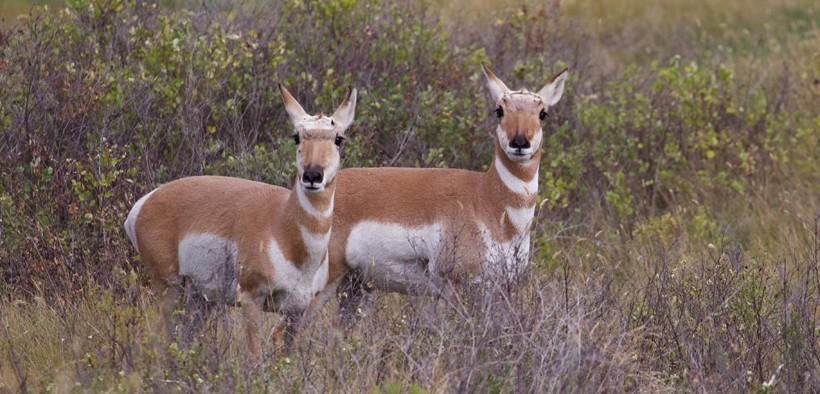
Pronghorns shed the outer sheath of their horns every year
?
Image credits: Tom Reichner/Shutterstock
Besides the obvious similarities in appearance, pronghorns are different from antelopes in other ways. To start with, antelopes are found only in Europe and Africa, whereas pronghorns are the natives of North America. Pronghorns shed the outer sheath of their horns once a year while antelopes keep their horns for life.
Anatomy and Characteristics
Pronghorns are hoofed animals similar to giraffes, goats and antelopes. Like deer, they have long snouts, long legs and short tails.
The upper body and the exterior part of the legs are reddish or light tan. The belly, chest, interior part of the legs, lower jaw, cheeks and the sides are white. Also, they have two white broad patches around the throat. Males have black markings on the face and neck contrary to the females. The rump patch extra long white hairs of about 7–10 cm (2.8–4 in) that can stick up when the pronghorn is scared. This is a signal to other pronghorns that there is danger nearby. This hair is absent in the A. a. mexicana subspecies.
Pronghorns have large, protruding eyes with an enhanced vision. The eyes are protected from the sun by a set of long, black eyelashes. The long limbs and lightweight bone structure support the animal during long distance running at high speed. The hooves have a cartilaginous padding to minimize shocks upon landing while running on rocks and hard ground. The front hooves carry most of the body weight during running, reason why they are bigger than the back hooves. Males and females have oil-secreting glands in the hooves. This oil acts as a conditioner for the hooves. Female pronghorns strike with their front hooves during encounters.
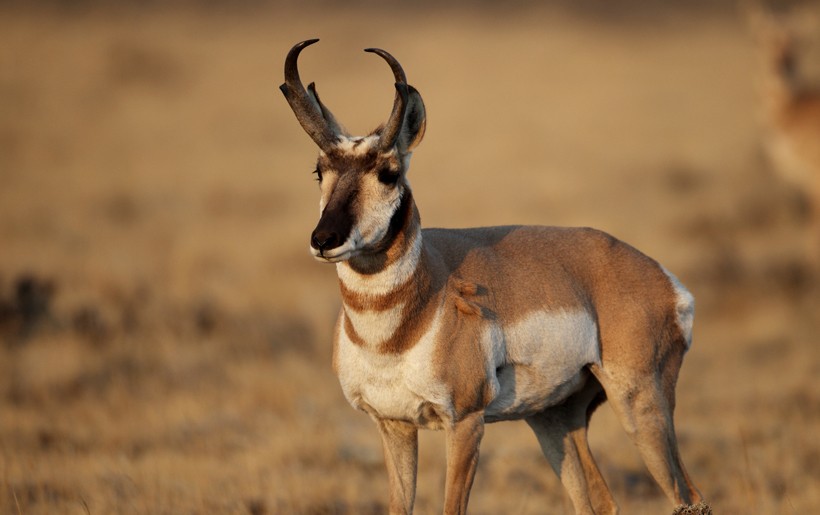
Pronghorns are associated with flat terrain, treeless, short-grass prairies.
?
Image credits: Dennis W. Donohue/Shutterstock
Pronghorns have a small digestive system that help them conserve energy during movement. With relatively large lungs, tracheae and heart, pronghorns can inhale oxygen faster and increase the rate of circulation.
The forked horns is what distinguishes pronghorns from its other family members. The horns are developed after 3 years. The horns are black and composed of a bony interior knob which is covered by a keratinous sheath. The pronghorns shed this sheath every year. Males have more prominent horns than females. The lyre-shaped curved horns of males are used to attack the opponents during male competitions. They thrust, and give serious stabs with these horns.
Habitat
These graceful creatures are found only in North America. They prefer shrub lands, grasslands, shrubby vegetation and temperate deserts. Pronghorns are associated with flat terrain and treeless short-grass prairies. They are found also on steppes with vegetation that grows about 13–76 cm in height. It is known that pronghorns are interchanging between their summer and winter habitats.
In the United States, pronghorns inhabit southern Idaho, Oregon, Montana, Arizona, western Texas and western North Dakota. Southern Alberta and Saskatchewan in Canada as well as Northern Mexico also contain pronghorn populations.
Diet & Predators
Pronghorns are opportunistic herbivores, browsing and grazing on a wide variety of plants. They prefer a protein-rich diet such as succulents (cacti), rabbitbrush, bluegrass, bunchgrass, ricegrass, sagebrush, squirreltail, and bitterbrush. All parts of the plant, knowing leaves, stem, fruits and flowers are eaten by pronghorns. These mammals are also fond of fruits and flowers like white daisy, paper flower, stick leaf and wooly senecio. The four-chambered stomach helps them to digest the plant cellulose. It has been calculated that one cow requires the same amount of food as 38 pronghorns do.
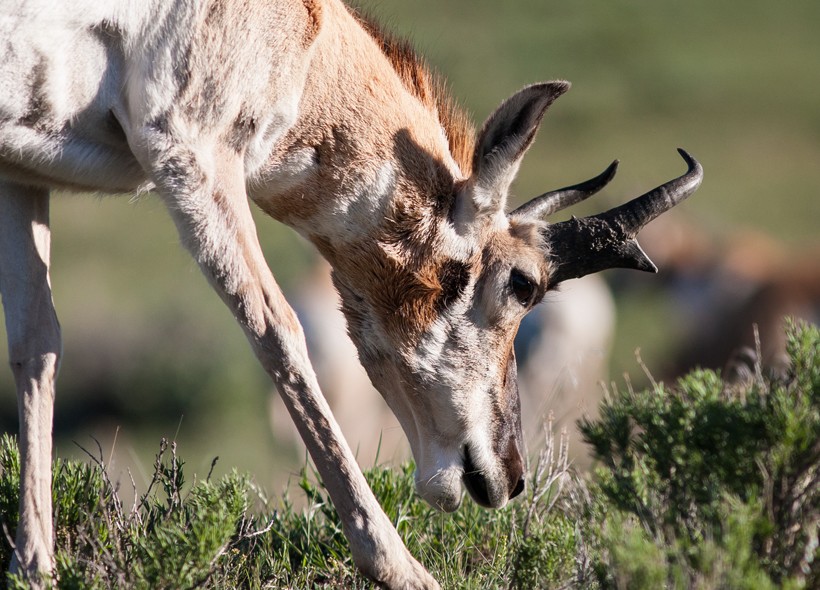
Pronghorns are herbivores, browsing and grazing on a wide variety of plants
?
Image credits: Jean-Edouard Rozey/Shutterstock
40 to 60 percent of the day is spent for feeding. They search for food at dawn and dusk. Pronghorns switch from season to season to optimize the benefits of the food available. More browsing is done during fall compared to summer. During winter, pronghorns consume huge quantities of dried stems, stick leaf, Mexican tea, javelina bush, and sacahuiste. In springtime, more grasses is consumed.
Pronghorns are known for their high speed. The speed and exceptional eyesight help pronghorns to protect themselves against tough predators. The main predators of pronghorns are cougars, wild dogs, bobcats, golden eagles, mountain lions, coyotes, and dire wolves.
Reproduction and Life Cycle
Pronghorns are polygamous. Normally, female pronghorns choose mates by one out of three possible behaviors: sampling, inciting or silency.
By sampling behavior, the female visits multiple males and stays with each one for a couple of days. For mating in the week of her estrus (fertility period), the female usually returns to the chosen male it had visited before.
When using inciting behavior, the female pronghorn runs away from the males and thereby she stimulates chasing and competitive fights among the males. Usually the female mates with the winner afterward.
When the so-called silence behavior is used, the female retires to an isolated place a month before her estrus. The area is typically occupied by a single male pronghorn. The female stays with the male and mates.
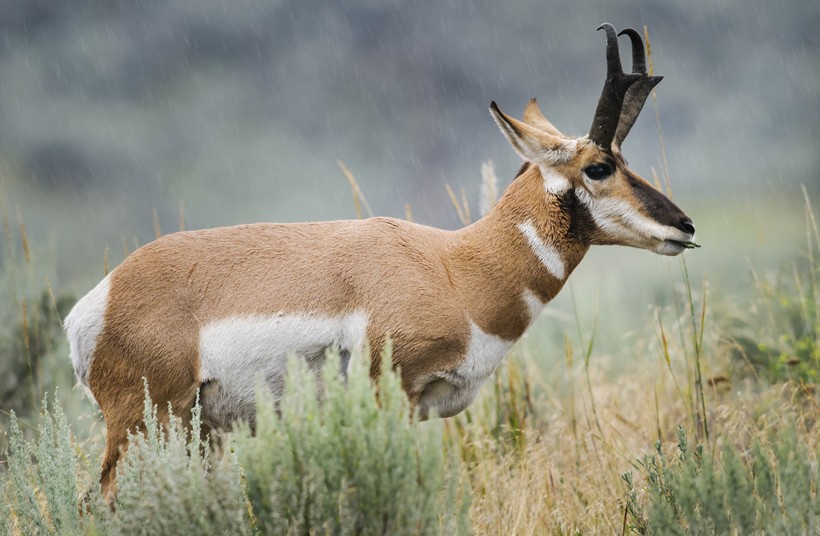
Female pronghorns choose mates through three ways: sampling, inciting, and quiet.
?
Image credits: BGSmith/Shutterstock
A male pronghorn attracts the female during her estrus with a high-pitched whine. The female stands and raises the tail. Sideways waving of the head, and pronounced gestures are used by the male while approaching the female. The male pronghorn makes low sucking sounds before mounting the female. The copulation itself occurs with one forceful pelvic thrust.
The territorial male protects the female pronghorn during estrus, and chases away other bachelor males that court the female.
Female pronghorns attain sexual maturity around 16–17 months whereas the males arrived sexual maturity around 1 year after birth. Pronghorns breed once every year. The birthing season is based on the environmental conditions and habitats. The northern populations breed around mid to late September and southern populations breed around September to October, although breeding has been observed during July too. Similarly, the birthing season for the northern populations is between May and June. For southern populations, the birthing period is around June to July.
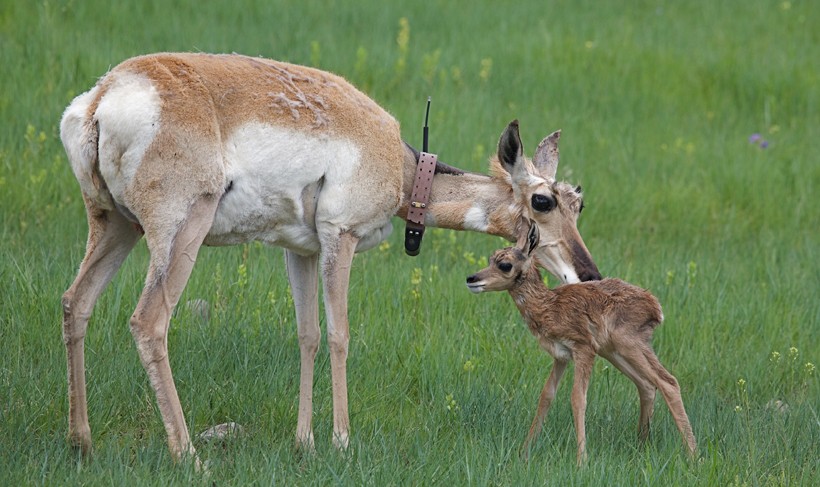
Mother with newborn, Custar State Park, South Dakota
?
Image credits: Tom Reichner/Shutterstock
Pronghorns have a gestation period of 245 to 255 days. After fertilization, the development of the ova can take about a month before it gets implanted. Females typically give birth to twins. However, subordinate females sometimes give birth to only one fawn.
The size of the fawns after birth is about 50-74 cm (20–29 in) long while they weight about 3-4 kg (7-9 lbs). Newborn twin fawns are relatively large with a high weight at birth; the combined weight of the fawns is almost 18% of the mother's weight. The first few days of newborns are spent hiding in the vegetation. Fawns are attached to their mothers, and interaction occurs for about half an hour daily. Female pronghorns are responsible for the parental care. They nurse, groom, and lead the fawns. They also protect the young ones from predators. Female pronghorns nurse the offspring thrice a day. Fawns are weaned till around 4–5 months after birth and the weaning stops a couple of weeks earlier for males compared to female fawns. The young ones reach their full weight upon 5 years whereby females show a faster growth than their male counterparts.
Behavior, Communication And Intelligence
As diurnal animals, pronghorns are active between dawn and dusk. They often sleep short periods of time. Their activities vary depending upon weather, season and location. Most of their time are spent in resting, feeding and ruminating.
Pronghorns live in a herd, showing an advanced social order. Typically, large herds are formed during winter time to protect themselves from predators, while dispersing during spring. Smaller herds of about 12 individuals in size are observed during summer.
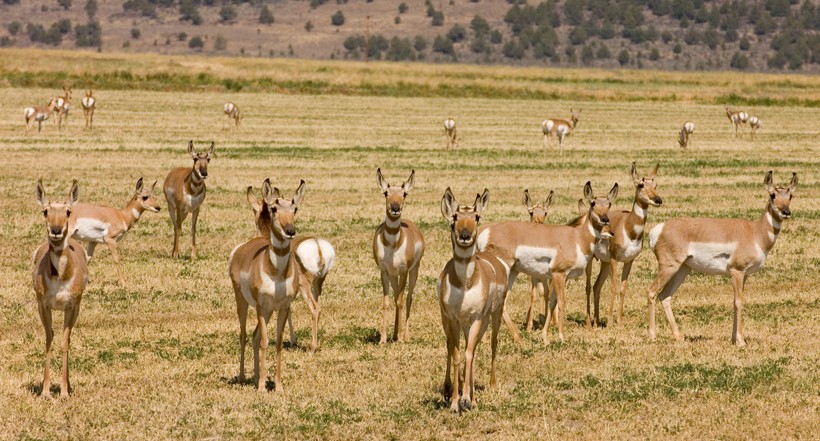
Large herds of pronghorns are formed during winter to protect themselves from the predators
?
Image credits: Jeffrey B. Banke/Shutterstock
Young pronghorn bucks come together in bachelor herds whereas adult males claim and defend their respective territories. To mark their territories, territorial males use various ways such as sniffing and urinating. They also mark the grasses in their territories with the secretions of the cheek glands. Territorial defense involves the following:- Stare at the intruder
- Warn the intruder by snorting and erecting the hair of rump patch
- Approach the intruder with stiff-leg gait with the head downwards
- In case the intruder don’t retreat, chase the intruder
Fights between male pronghorns are not very common and takes place only during the breeding season in front of a female.
Does and fawns use a combination of vocal, visual and olfactory cues for communication and recognition. Scent glands are typically used for interactions between adult males and females. Scent glands are also used to mark territories, for danger alert or to attack intruders.
Visual signs are used by male pronghorns as a warning in the form of erect hair on the rump patch in order to enhance their size. Likewise, pronghorns fold their ears down in order to make their horns and black markings more prominent.
Pronghorns use different types of vocalization for different purposes.- A snort-wheeze for warning
- A roar by rutting males
- A high-pitched whine during the courtship
- A bleat by fawns
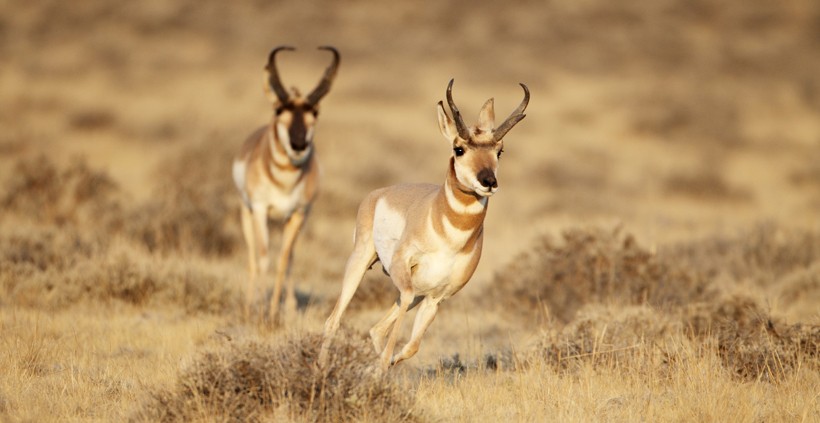
Pronghorns are known as the fastest hoofed animals
?
Image credits: Dennis W. Donohue/Shutterstock
Known as the fastest hoofed animals, pronghorns can run close to 92 km/h (57 mph). Although they are not as fast as the cheetahs, they can maintain the high speed for a longer period. While the cheetah may run out of energy, pronghorns won't. That's why they are regarded as the marathon runners in the wild.
Population and Conservation Status
In earlier times, there were over 35 million pronghorns in the wild. Unfortunately, their number decreased drastically because of loss of habitat and hunting. By the 20th century, the population gradually started to increase again as result of the conservation practices. Today, the estimated population is between 500,000 and 1,000,000 individuals.
With a stable population pronghorns fall under the "least concern" category. However, this cannot be stated for all subspecies. A. s. peninsularis and A. a. sonoriensis are endangered subspecies with only a few hundred individuals remaining.
Main threats that conflict to their survival are loss of habitat, destruction of vegetation, heavy livestock grazing and hunting. Rigorous conservation efforts have been made to stabilize the population.
Cultural Depictions
According to an Apache legend (Native American tribe), a beautiful young tribal woman was transformed into a pronghorn, and her descendants still roam in the wild. Anyone who eats pronghorns is believed to be eating the descendant of this young woman. For this reason, the Apaches never hunt pronghorns.
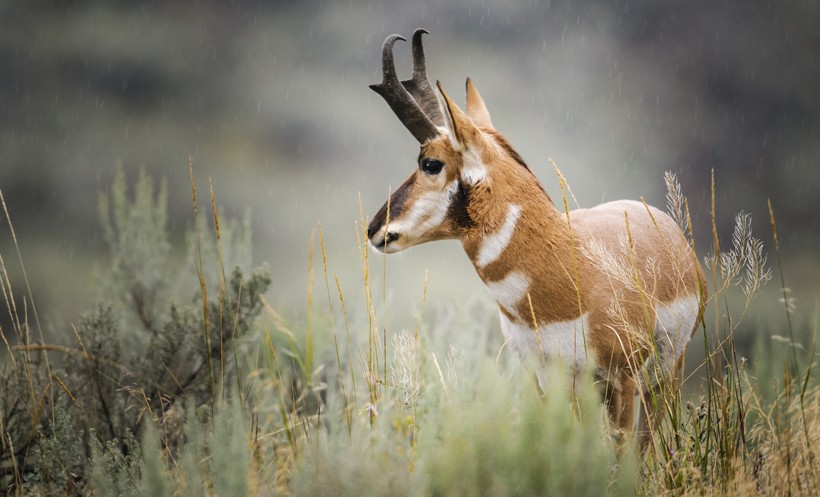
According to the Apache legend, pronghorns are descendants of a beautiful young tribal woman
?
Image credits: BGSmith/Shutterstock
However, other tribes in the range do hunting the pronghorns and use all the body parts. The meat is eaten, the skin is used for clothing, sinew is functioning as a thread, bladders become containers and bones are used as basic material for tools.
Pronghorns are also totem spirit animal-symbols to understand and achieve a higher life. People with pronghorn as their totem are focused on knowledge and seek spirituality.
Evolutionary History
Pronghorns that we see today are the only surviving species of the Antilocapridae family. Antilocapridae was originally divided into 2 subfamilies: the Antilocaprinae and the Merycodontinae. This last one became extinct by the end of the Miocene era. The Antilocaprinae evolved during the late Miocene era and survived as the Antelocapra americana or pronghorns.
The main difference between the pronghorn as we know today and its ancestor is the horn structure. The speed of pronghorn was evolved to be able to survive alongside its predators, making it one of fastest land animals.
Funfacts
- Pronghorns seldom jump. When they come across a fence, they normally crawl underneath instead of jumping over it.
- No land mammal can match pronghorns when it comes to long-distance running.
- They secrete compounds from their glands that contain same ingredients that are used in human skincare products.
